Old
Page 24
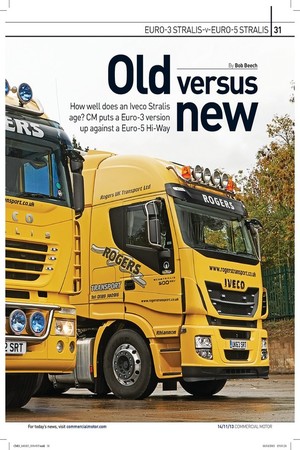
Page 25
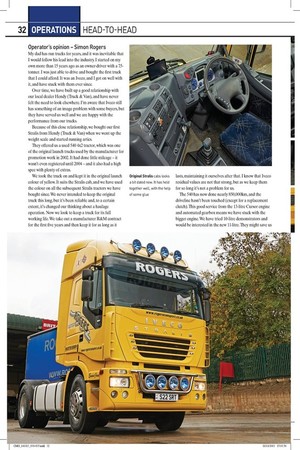
Page 26
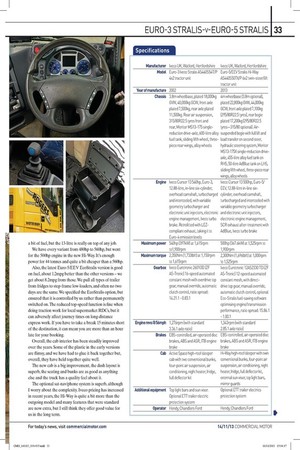
Page 27
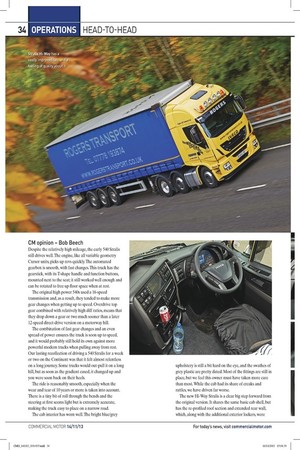
Page 28
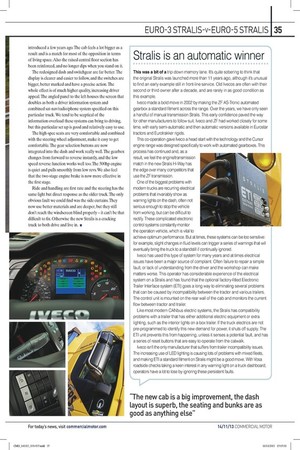
If you've noticed an error in this article please click here to report it so we can fix it.
versus
By Bob Beech How well does an Iveco Stralis age? CM puts a Euro-3 version up against a Euro-5 Hi-Way Operator's opinion Simon Rogers
My dad has run trucks for years, and it was inevitable that I would follow his lead into the industry. I started on my own more than 15 years ago as an owner-driver with a 7.5tonner. I was just able to drive and bought the first truck that I could afford. It was an Iveco, and I got on well with it, and have stuck with them ever since.
Over time, we have built up a good relationship with our local dealer Hendy (Truck & Van), and have never felt the need to look elsewhere. I'm aware that Iveco still has something of an image problem with some buyers, but they have served us well and we are happy with the performance from our trucks.
Because of this close relationship, we bought our first Stralis from Hendy (Truck & Van) when we went up the weight scale and started running artics.
They offered us a used 540 4x2 tractor, which was one of the original launch trucks used by the manufacturer for promotion work in 2002. It had done little mileage — it wasn't even registered until 2004— and it also had a high spec with plenty of extras. We took the truck on and kept it in the original launch colour of yellow. It suits the Stralis cab, and we have used the colour on all the subsequent Stralis tractors we have bought since. We never intended to keep the original truck this long, but it's been reliable and, to a certain extent, it's changed our thinking about a haulage operation. Now we look to keep a truck for its full working life. We take out a manufacturer R&M contract for the first five years and then keep it for as long as it
lasts, maintaining it ourselves after that. I know that Iveco residual values are not that strong, but as we keep them for so long it's not a problem for us. The 540 has now done nearly 850,000km, and the driveline hasn't been touched (except for a replacement clutch). This good service from the 13-litre Cursor engine and automated gearbox means we have stuck with the bigger engine. We have tried 10-litre demonstrators and would be interested in the new 11-litre. They might save us
a bit of fuel, but the 13-litre is really on top of any job.
We have every variant from 480hp to 560hp, but went for the 500hp engine in the new Hi-Way. It's enough power for 44 tonnes and quite a bit cheaper than a 560hp.
Also, the latest Euro-5/EEV EcoStralis version is good on fuel, about 1.2mpg better than the other versions — we get about 8.2mpg from those. We pull all types of trailer from fridges to step-frame low-loaders, and often no two days are the same. We specified the EcoStralis option, but ensured that it is controlled by us rather than permanently switched on. The reduced top-speed function is fine when doing traction work for local supermarket RDCs, but it can adversely affect journey times on long-distance express work. If you have to take a break 15 minutes short of the destination, it can mean you are more than an hour late for your booking.
Overall, the cab interior has been steadily improved over the years. Some of the plastic in the early versions are flimsy, and we have had to glue it back together but, overall, they have held together quite well. The new cab is a big improvement, the dash layout is superb, the seating and bunks are as good as anything
else and the truck has a quality feel about it.
The optional sat-nay/phone system is superb, although I worry about the complexity. Iveco pricing has increased in recent years, the Hi-Way is quite a bit more than the outgoing model and many features that were standard are now extra, but I still think they offer good value for us in the long term. CM opinion Bob Beech
Despite the relatively high mileage, the early 540 Stralis still drives well. The engine, like all variable geometry Cursor units, picks up revs quickly. The automated gearbox is smooth, with fast changes. This truck has the gearstick, with its T-shape handle and function buttons, mounted next to the seat; it still worked well enough and can be rotated to free up floor space when at rest.
The original high power 540s used a 16-speed transmission and, as a result, they tended to make more gear changes when getting up to speed. Overdrive top gear combined with relatively high cliff ratios, means that they drop down a gear or two much sooner than a later 12-speed direct-drive version on a motorway hill.
The combination of fast gear changes and an even spread of power ensures the truck is soon up to speed, and it would probably still hold its own against more powerful modern trucks when pulling away from rest. Our lasting recollection of driving a 540 Stralis for a week or two on the Continent was that it felt almost relentless on a long journey. Some trucks would out-pull it on a long hill, but as soon as the gradient eased, it changed up and you were soon back on their heels.
The ride is reasonably smooth, especially when the wear and tear of 10 years or more is taken into account. There is a tiny bit of roll through the bends and the steering at first seems light but is extremely accurate, making the truck easy to place on a narrow road. The cab interior has worn well. The bright blue/grey
upholstery is still a bit hard on the eye, and the swathes of grey plastic are pretty dated. Most of the fittings are still in place, but we feel this owner must have taken more care than most. While the cab had its share of creaks and rattles, we have driven far worse. The new Hi-Way Stralis is a clear big step forward from the original version. It shares the same basic cab shell, but has the re-profiled roof section and extended rear wall, which, along with the additional exterior lockers, were
introduced a few years ago. The cab feels a lot bigger as a result and is a match for most of the opposition in terms of living space. Also the raised central floor section has been reinforced, and no longer dips when you stand on it.
The redesigned dash and switchgear are far better. The display is clearer and easier to follow, and the switches are bigger, better marked and have a precise action. The whole effect is of much higher quality, increasing driver appeal. The angled panel to the left houses the screen that doubles as both a driver information system and combined sat-nay/radio/phone system specified on this particular truck. We tend to be sceptical of the information overload these systems can bring to driving, but this particular set up is good and relatively easy to use.
The high-spec seats are very comfortable and combined with the steering wheel adjustment, make it easy to get comfortable. The gear selection buttons are now integrated into the dash and work really well. The gearbox changes from forward to reverse instantly, and the low speed reverse function works well too. The 500hp engine is quiet and pulls smoothly from low revs. We also feel that the two-stage engine brake is now more effective in the first stage. Ride and handling are first rate and the steering has the same light but direct response as the older truck. The only obvious fault we could find was the side curtains. They now use better materials and are deeper, but they still don't reach the windscreen blind properly – it can't be that difficult to fix. Otherwise the new Stralis is a cracking truck to both drive and live in. •








































